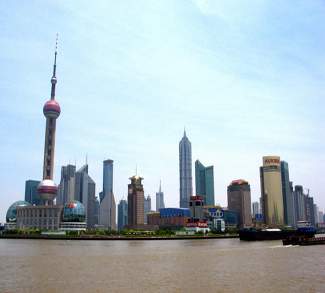China’s widening trade surplus and the growing US trade deficit since the COVID-19 pandemic have renewed concerns about global imbalances, fueling an intense debate on their causes and consequences. There are increasing worries that China’s external surpluses result from industrial policy measures designed to stimulate exports and support economic growth amid weak domestic demand and deflation. Some are even warning that the resulting overcapacity could lead to a “China Shock 2.0”—a surge of exports that would displace workers and hurt industrial activity elsewhere.
This trade and industrial policy centered view of external balances, of course, is incomplete at best and should be replaced with a macro view. External balances are ultimately determined by macroeconomic fundamentals, while the link to trade and industrial policy is more tenuous. To understand the pattern of global external imbalances, we need to understand the macroeconomic drivers of desired saving relative to desired investment, not only in China but also in the rest of the world, including the United States. While other countries contribute to global imbalances, the United States and China together account for about one-third of the global current account balance.
Macroeconomic forces
China’s trade surplus increased substantially at the beginning of the pandemic. Initially, exports of medical equipment surged and consumers around the world increased purchases of goods relative to services due to social distancing. Then domestic demand in China weakened substantially starting in late 2021 in the wake of large-scale property market troubles and repeated lockdowns in 2022 that hurt consumer confidence.
The resulting drag on China’s real economy has been significant as household saving rates increased and investment contracted. At the same time that domestic demand in China weakened, global demand was boosted by significant dissaving—particularly in the United States, where the fiscal deficit grew substantially relative to the pre-pandemic era and the household saving rate halved. Thus, the pandemic created two different societal reactions in China and the United States, and these respective reactions have had an impact on subsequent trade imbalances between the two countries. It turns out that keeping the US economy running was much more expensive than the Chinese economy because Beijing did not spend a lot on employee compensation during the lockdowns. The end result of these imbalances also differs: inflation in the United States, and the present deflation in China.
Another result is that China’s trade balance now stands at between 2-4 percent of gross domestic product, depending on the methodology (see China Article IV for details of the differences). The composition reflects weak imports combined with a large rise in China’s global export share.
This trade surplus as a share of economic output is smaller than during the “China Shock” of the 2000s (at its peak, around 10 per cent of China’s GDP). However, China now accounts for a substantially larger share of the global economy, so much so that even though its trade surplus is smaller relative to its economy, as a share of global output it has remained fairly stable over time. Hence spillovers from trade developments in China continue to be quite sizable for the rest of the world.
An IMF analysis—stylized simulations using the IMF’s G20 model—illustrates that macroeconomic factors are driving these external developments. These include negative domestic demand shocks in China, due to the property market downturn and low household confidence, as well as a dissaving shock in the United States due to elevated government and personal spending. That is why talking about trade imbalances is like discussing saving vs. dissaving behaviors in societies. It is a bit different from the single-focused emphasis on discussing the malicious Chinese government’s economic ambitions.
This “macro” view predicts outcomes close to what the data illustrates. Largely because of weak domestic demand, China’s current account surplus is boosted by about 1.5 percentage points, close to the increase seen in the data relative to its pre-pandemic level. The persistent surge in China’s domestic savings results in a large depreciation of its real effective exchange rate, consistent with data since 2021. This relative price adjustment supports export growth and depresses import demand.
The United States presents a mirror image. Largely because of strong domestic demand, the U.S. current account balance deteriorates by around 1 percentage point in the model—close to the decrease seen in the data relative to its pre-pandemic level.
Importantly, the persistent decline in US domestic savings leads to a rise in US real interest rates that broadly offsets the negative effect of increased Chinese savings on global rates.
Two key takeaways
Unlike the 2000s, when excess savings originating in emerging Asian economies contributed to global imbalances and depressed world interest rates, there is no global savings glut this time. Global real rates outside China have increased, not decreased.
The contribution of the Chinese saving shock to the US external balance is small, and so is that of the US dissaving shock to China’s trade balance. External surpluses and deficits in both countries are mostly homegrown.
Homegrown surpluses and deficits call for homegrown solutions that require setting the macro dials appropriately. Attempts at stimulating growth through its external sector are likely to face significant headwinds. The economy is just too large—a sign of its success—to generate much growth from exports only.
More fundamentally, China needs to rebalance its economy through comprehensive macro and structural reforms. The right approach consists of a multi-pronged strategy that includes implementing a policy package to make the property sector adjustment less costly; a demand-side stimulus focused on households; and reforms to structurally strengthen safety nets, reduce income inequality, and improve resource allocation. Some of these measures however may undermine the Party’s control of the national economy and are not very plausible for practical implementation.
For the United States, external balances will benefit from a significant fiscal adjustment. This can be achieved through a variety of ways, including raising indirect taxes, progressively increasing income taxes, eliminating a range of tax expenditures, and reforming entitlement programs. Determining a re-shoring policy and government spending on it are also reasonable. Put simply, this means an austerity program to be deployed in combination with targeted investment priorities furthering government policies. The most fundamental of the priorities should be aimed at industrial competitiveness improvement, which includes both the volume of output and export increase far not only in the hi-tech sectors. Unfortunately, none of the presidential candidates in the country seem concerned by this problem, and neither appears to possess the moral authority and leadership to stand up against the mass social expectations against the austerity measures.
Subsidies and industrial policy
But what about industrial and trade policies spurring concerns in the United States and the West over the “overcapacity” in China?
Data from the Global Trade Alert show that China has implemented around 5,400 subsidy policies from 2009 to 2022, which is equal to about two-thirds of all the measures adopted by G20 advanced economies combined. China’s subsidies are concentrated in priority sectors such as software, automobiles, transportation, semiconductors, and more recently, green technology. Yet, the country’s manufacturing trade surplus is not concentrated among any specific industries and the share of the major sectoral contributors has remained fairly stable over time. Subsidies for electric vehicles and other green technology goods have received widespread attention as exports have surged. Indeed, China was the largest manufacturer of EVs in 2023, producing 8.9 million EVs (about two-thirds of annual global EV production) and exporting 1.2 million—making China the leading exporter of electric vehicles. But as of now these exports only account for about 1 percent of Chinese goods.
The IMF staff analysis indicates that these subsidies do play some role in generating international trade spillovers in the respective sectors. After the introduction of a subsidy, China’s exports of subsidized products are 1 percent higher than those of non-subsidized products. Imports of subsidized products are lower, indicating some domestic substitution. The estimated effects are however modest, suggesting that industrial policies have a limited impact on aggregate external balances.
Beyond China, many countries like the United States, are rapidly ramping up their use of industrial policies. Emerging economies, where such measures were historically more prevalent, still retain a large number of them. Even if they may not be the major factor driving countries’ overall external surpluses, they still matter. These may well generate sizable negative spillovers in trading partners, by undercutting the competitiveness and market access in other countries, exacerbating trade tensions.
China’s trade surpluses do not come explicitly from a government industrial policy. Neither is the US trade deficit accumulating due to a lack of government industrial policy. Both the surplus and the deficit are functions of the national saving propensities, and they match each other essentially on the global market. If US consumption is about one-third of the global level, Chinese manufacturing is almost there as a percentage of world manufacturing output, too. However, it is not a win-win match. The winning party is China because it has a stronger industrial sector, larger exports, dominance in key international supply chains, more production investments worldwide and the possibility to develop offshore projects with geopolitical significance, which the U.S. cannot raise capital for. Moreover, the Chinese government is not interested in improving its social security nets and income policies, or backing up massively the fragile real estate sector, even if these reflect negatively on GDP growth. Thus, the surpluses and moderate policies for increasing consumer demand domestically will not remove China’s pressure on the global and US economy anytime soon.
Moreover, if other countries are successful in developing their own industrial policies, it presumes that the US economy will continue to lose weight in global markets. It is inevitable in fact. Thus, if the U.S. wants the trade fragmentation and re-blocking processes completed in the newly looming version of the globalization model not to work entirely to the detriment of its consumption-based economy with low saving rates, it should connect its economic priorities with geopolitics and adopt a strategy. No tariffs by themselves could replace the comprehensive impact of such an approach, as tariffs cannot influence the saving rates in either the United States or China. The universal tariffs of the Trump platform will only lead the US economy toward higher inflation, isolationism, and lower competitiveness.
The sectorial application of tariffs on the other hand, absent other macroeconomic instruments, also does not do the job. For example, Trump’s 25% tariff on steel imports from China imposed in 2018 did not augment jobs in the sector, as in 2020 their number was still 80 000 while in 2018 it was 84 000. In 2016, before Trump took office, the US total goods and services deficit was $480 billion, around 2.5% of GDP. By 2020, it had grown to $653 billion, around 3% of GDP, despite tariffs. Further, tariffs tend to simply be bypassed by China; for example, in US imports of solar panels, of which manufacturing is shifted to Malaysia, Thailand, Cambodia, and Vietnam. This is another example of tariff inefficiency, and it mirrors the case of vehicle spare parts manufacturing being relocated to Mexico and thus evading again tariffs targeting China’s exports.
If tariffs (Trump) or silence on foreign trade (Harris) cannot influence saving rates and raise production capacity, neither can they improve economic competitiveness nor add jobs. On the other hand, a good (from a geopolitical point of view) investment and re-shoring strategy can achieve these goals. The strategy should be focused on not only the government refunding of companies’ re-shoring logistics cost but on encouraging US private FDI in the ASEAN countries and Eastern Europe, too. It sounds heretical in the United States today if the government spends tax revenue abroad for subsidies aimed at private companies’ support, but the low-cost manufacturing driver for the domestic economy otherwise is unreachable. It is enough for the government in this situation to support solely overseas projects, which intend to produce or export their end output in/from the United States, using manufacturing outsourcing for the purpose. It must be remembered that lower cost means higher labor productivity and stronger international competitiveness. Without improving its international competitiveness, the US economy will always be vulnerable to inflationary pressure and redundancy, and the least of all any tariffs or silence on the matter will help.
Conclusion
If the US economy’s share of global economic activity inevitably shrinks, an efficient trade policy would make the US economy relatively stable amid the inflationary and unemployment vulnerabilities resulting from this smaller share. This path requires the improvement of US competitiveness by increasing industrial output volumes in some consumer and export sectors as well as reducing the trade deficit. The latter can be achieved by taking advantage of low-cost manufacturing drivers coming from more overseas investments in ASEAN countries and Eastern Europe, leveraged by the US government and growing the overall trade share in GDP. Improved competitiveness with import tariffs alone cannot be attained. Neither can it come from the hi-tech sector being leveraged solely. Any sustainable improvements need a wider range of investments and good trade management. Tariffs cannot erase the Chinese industrial export surpluses, either.
The views expressed in this article belong to the author(s) alone and do not necessarily reflect those of Geopoliticalmonitor.com.




